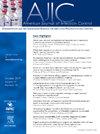Vaccination coverage outcomes and health care organization program implementers’ experiences after introduction of a health care worker influenza vaccination mandate in Victoria, Australia, 2022-2023
IF 2.4
3区 医学
Q2 INFECTIOUS DISEASES
引用次数: 0
Abstract
Background
In 2022, the Victorian government, Australia, introduced a seasonal influenza vaccination mandate for specified health care workers (HCW). We describe implementation of the mandate’s requirements in health care organizations by
- (1)Reporting 2022 and 2023 HCW vaccination coverage rates
- (2)Describing the experiences of vaccination program implementers.
Methods
An analysis was undertaken of annual organizational surveillance data routinely reported by health care organizations to the coordinating center from 2018 to 2023. Focus group interviews with program implementers were conducted.
Results
Annual vaccination coverage increased from a median of 85.4% (2018-2021) to 93.6% (2022-2023). Those with “unknown status” and declinations decreased from a median of 8.2%-5.1% and 5.0%-1.1%, respectively. Implementers described increased leadership support and accountability for program delivery, and a focus on educating HCWs on the mandate and how to provide evidence of vaccination. New challenges included interpreting the mandate and applying pragmatic consequences. Implementers described increased administrative burden and seeking technological solutions.
Conclusions
Introduction of the mandate coincided with an increase in HCW influenza vaccination coverage and changes to program delivery. Investment in technological solutions can support surveillance by reducing the administrative burden and potentially increasing reporting accuracy of number of HCWs with “unknown status.”
在澳大利亚维多利亚州,2022-2023年引入卫生保健工作者流感疫苗接种任务后,疫苗接种覆盖率结果和卫生保健组织计划实施者的经验。
背景:2022年,澳大利亚维多利亚州政府对特定卫生保健工作者(HCW)实施了季节性流感疫苗接种任务。我们通过方法描述了在医疗保健组织中执行任务要求的情况:对2018年至2023年医疗保健组织定期向协调中心报告的年度组织监测数据进行了分析。与项目执行者进行焦点小组访谈。结果:年疫苗接种率中位数从85.4%(2018-2021)增加到93.6%(2022-2023)。那些“身份不明”和衰退的人中位数分别从8.2%下降到5.1%和5.0%下降到1.1%。实施者描述了加强对规划实施的领导支持和问责制,以及重点对卫生保健员进行任务和如何提供疫苗接种证据的教育。新的挑战包括解释任务规定和应用实际后果。实现者描述了增加的管理负担和寻求技术解决方案。结论:该任务的推出恰逢HCW流感疫苗接种覆盖率的增加和规划实施的变化。对技术解决方案的投资可以通过减少行政负担和可能提高“状况不明”的卫生保健工作者数量的报告准确性来支持监测。
本文章由计算机程序翻译,如有差异,请以英文原文为准。
求助全文
约1分钟内获得全文
求助全文
来源期刊
CiteScore
7.40
自引率
4.10%
发文量
479
审稿时长
24 days
期刊介绍:
AJIC covers key topics and issues in infection control and epidemiology. Infection control professionals, including physicians, nurses, and epidemiologists, rely on AJIC for peer-reviewed articles covering clinical topics as well as original research. As the official publication of the Association for Professionals in Infection Control and Epidemiology (APIC)

 求助内容:
求助内容: 应助结果提醒方式:
应助结果提醒方式:


